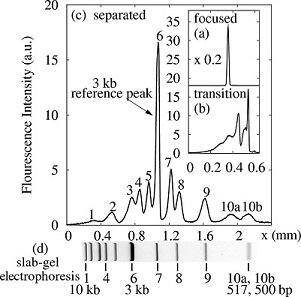Docket #: S10-201
Automated and Integrated High Sensitivity Preconcentration and Separation with Isotachophoresis
Researchers in Prof. Juan Santiago's laboratory have developed a novel isotachophoresis (ITP) method to easily and seamlessly integrate various electrophoresis-based detection techniques with ITP preconcentration. The technique's variations include, but are not limited to, coupling multiple ITP processes, integrating ITP preconcentration with electrophoretic separation, and coupling the application of ITP to achieve fast chemical reactions with electrophoretic separation. The technique requires no manual or voltage control steps to initiate the transition from ITP to other electrophoretic processes. For example, the transition requires no exchange of buffers, switching of flows, or changing the state of power supplies. The technology is applicable to on-chip or off-chip electrophoresis systems (e.g., microfluidic chips or free-standing capillaries). Also, it requires low amounts of initial sample and can be easily integrated into conventional on- or off-chip capillary electrophoresis (CE) equipment.
Stage of Research
The inventors have demonstrated the technique with high resolution separation of ds-DNA fragments of a 1 kb DNA ladder. The figure below shows a separation of a 1 kb ds-DNA ladder using this technique. Each element of the ladder is fully resolved, including the 517 vs. 500 bp fragments not resolved by typical slab-gel electrophoresis (shown below the plot).

Preconcentration and subsequent separation of 1 kb ds-DNA ladder using this novel technique. (a) shows initial ITP-focused DNA fragments. (b) shows the transition from focusing to separation stage. (c) shows fully resolved DNA ladder, with 11 peaks. (d) shows visualization (inverted) of agarose gel electrophoresis separation (provided by the vendor, New England BioLabs, Ipswich, MA). Note that the agarose gel electrophoresis does not resolve peaks 10a and 10b corresponding to 517 and 500 bp fragments, while our on-chip ITP technique does resolve this.
The inventors have also demonstrated 20-fold increase in sensitivity of ITP detection of small ions in water, for example 2,4,6-tricholorophenol (a herbicide), by coupling two ITP processes with different electrolyte solutions.
Applications
- High sensitivity DNA separations for genetic analysis
- High sensitivity RNA separations to assess RNA degradation (RNA integrity)
- ITP purification to remove contaminants, for example purification and separation of DNA from samples with protein contaminants
- Preconcentration and detection of pollutants and toxins for environmental monitoring and water quality testing
Advantages
- Automated transition from ITP focusing to other electrophoretic processes (no intermediate steps are involved)
- High sensitivity: ITP preconcentration step prior to detection enhances sensitivity, which allows use of cheap detectors
- Fast separations - compared to conventional transient ITP where leading electrolyte (LE) ions injected behind trailing electrolye (TE) zone take time to overtake focused analytes
- High resolution separations
- initial focusing of analytes in a sharp zone
- much less electromigration dispersion compared to transient ITP
- Small sample requirements due to preconcentration step prior to detection, and relatively small dimensions of the reservoir and microchannel
- Compatible with CE - the process is easily integrated in conventional single channel CE equipment or into on-chip CE microfluidic chips
- Easy purification - the initial separation step can also be used as purification step to selectively focus analytes of choice and reject unwanted sample components such as proteins in DNA analysis
Publications
- US Published Patent Application 20120061242, "Isotachophoresis having interacting anionic and cationic shock waves"
Related Links
Patents
- Published Application: 20120061242
- Issued: 8,986,529 (USA)
Similar Technologies
-
Eco-friendly method that produces ammonia and urea for fertilizer and other uses S22-335Eco-friendly method that produces ammonia and urea for fertilizer and other uses
-
Wireless, Ultra-Low Power Implantable Device S13-173Wireless, Ultra-Low Power Implantable Device
-
Fully Water-Soluble, Fluorescence-Based, Synthetic Small-Molecule Hydrazine Sensor for Liquid Analysis S17-114Fully Water-Soluble, Fluorescence-Based, Synthetic Small-Molecule Hydrazine Sensor for Liquid Analysis